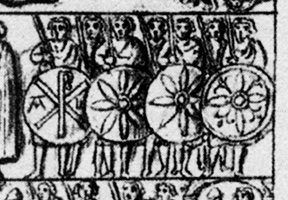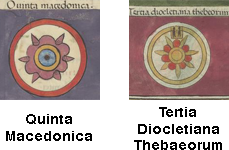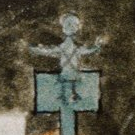
This page created 23 March 2014, and last modified: 23 September (Cstandard section added)

The Tertia Diocletiana Thebaeorum is listed (18.15 in Ingo Maier's numbering scheme) as the fourth of the legiones comitatenses under the Magister Militum per Thracias. Its shield pattern (16#5) is shown in various manuscripts, under the matching label (16.e) Tertia Diocletiana Thebaeorum, as below:

The pattern is relatively ornate, and shows a yellow boss encircled by a yellow band; the outer rim of the shield is red (white in P), while a yellow band (white in W) immediately inwards. The main ground is white (blue in M). Radiating out from the inner yellow band to the outer yellow band are seven yellow petals (six in M, B); in between each adjacent pair is a smaller red petal. A rectangular imago (imperial portrait) bearing two small black figures overlays the main field and the outer yellow rim at the 12 o'clock position; in the case of W, the original drawing of these figures has been crudely inked over so they look just like black lines (see Maier, I.G., The Barberinus and Munich codices of the 'Notitia Dignitatum omnium': Latomus 28 1969 pp. 960-1035; available here).
The seven-fold symmetry of the shield pattern is unusual; and can only be found elsewhere with the patterns ascribed to the Solenses seniores (18.12) and the Constantini Dafnenses (18.23), both also under the Magister Militum per Thracias, and also the Martii (21.16), under the Magister Militum per Illyricum. The long + short petal arrangement is known from the Column of Arcadius in Istanbul, the majority of which was demolished ca. 1717 due to earthquake damage, but whose decorative reliefs were recorded in sketches executed in 1574 by an anonymous German artist. The relevant pattern comes from left-most guardsman flanking the emperors Arcadius and Honorius illustrated on the west face of the column's base, as shown below:

The symmetry is however different in this case. The shield pattern also bears a definite stylistic resemblance to that of the Quinta Macedonica (15.16) under the Magister Militum per Orientem, as can be seem below from the following patterns taken from the Paris manuscript:

Perhaps these two detachments were posted simultaneously to the same command and thus received similar shield patterns, but were later separated. Given the Legio quinta Macaedonica (52.2), stationed at Memfi under the Comes limitis Aegypti, and the Legio tertia Diocletiana stationed at Ambos (56/7.10) and Thebas (56/7.17) under the Dux Thebaidos, as well as at Andro (52.6) under the Comes limitis Aegypti, after their initial posting upon leaving Egypt seems likely.
The Tertia Diocletiana Thebaeorum is likely to have been one of the "Theban legions" that Ammianus refers (14.11.15) to as being stationed near Adrianople in Thrace in 354. There are six "Theban" legions in the Notitia (not counting detachments of the same legion as extra legions):
98/9.30 Thebei, in the Magister Peditum's Italian command;Of these, the Thebei in the Notitia is a western unit, and perhaps unlikely to have been in the east at the time; the Secunda Felix Valentis Thebaeorum had not yet been raised, and the Oriental Secunda Flavia Constantia Thebaeorum detachment had probably yet to leave its parent unit in Egypt, leaving the Prima Maximiana Thebaeorum and the Tertia Diocletiana Thebaeorum as "the Theban legions".
18.14 Prima Maximiana Thebaeorum, under the Magister Militum per Thracias;
18.15 Tertia Diocletiana Thebaeorum, also under the Magister Militum per Thracias;
15.22 Secunda Flavia Constantia Thebaeorum, under the Magister Militum per Orientem;
15.23 Secunda Felix Valentis Thebaeorum, also under the Magister Militum per Orientem; and
56/7.11 Legio secunda Flavia Constantia Thebaeorum, under the Dux Thebaidos.
Interestingly, an image of the standard of the Legio tertia Diocletiana Thebaidos (52.6) detachment stationed at Andro may have survived: the frontpiece for the Comes limitis Aegypti uniquely illustrates what may well be standards of some of the Egyptian units arising out of their station depictions. Nine such decorated poles are shown: two are clearly of the aquila (Eagle)-type, five are of the imago (Imperial portrait)-type, one's shape is hard to discern, and one is a globus cruciger (orb surmounted by a cross). That shown in Andro, and thus presumably belonging to Legio tertia Diocletiana Thebaidos, is of the imago-type, with a single figure apparently surmounting a crudely-drawn vexillum (flag suspended from a cross-bar), as can be seen from the close-up of the image shown in the Bodleian manuscript (O) below:

It is possible other detachments of the legion carried similar standards. That the Thracian unit's shield pattern shows two people, while the Egyptian standard shows just one is interesting: the sizes of the illustrations mean details of the figures, and thus identities, are impossible to discern from the figures below, but since the unit is named after Diocletian, one may surmise the lone figure represents Diocletian; the twinned figures would thus represent Diocletian and his fellow Augustus, Maximian.

Return to the Notitia alphabetical unit list page.
Return to my Notitia index page.